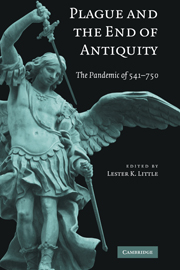Book contents
- Frontmatter
- Contents
- Contributors
- Preface
- Map
- Plague and the End of Antiquity
- I INTRODUCTION
- II THE NEAR EAST
- 3 ‘For Whom Does the Writer Write?’
- 4 Justinianic Plague in Syria and the Archaeological Evidence
- III THE BYZANTINE EMPIRE
- IV THE LATIN WEST
- V THE CHALLENGE OF EPIDEMIOLOGY AND MOLECULAR BIOLOGY
- Bibliography
- Index
3 - ‘For Whom Does the Writer Write?’
The First Bubonic Plague Pandemic According to Syriac Sources
Published online by Cambridge University Press: 05 June 2012
- Frontmatter
- Contents
- Contributors
- Preface
- Map
- Plague and the End of Antiquity
- I INTRODUCTION
- II THE NEAR EAST
- 3 ‘For Whom Does the Writer Write?’
- 4 Justinianic Plague in Syria and the Archaeological Evidence
- III THE BYZANTINE EMPIRE
- IV THE LATIN WEST
- V THE CHALLENGE OF EPIDEMIOLOGY AND MOLECULAR BIOLOGY
- Bibliography
- Index
Summary
Syriac literature has a good deal to say about the first pandemic of bubonic plague from 541 to 749 CE. This includes information about the geographical spread and extent of the initial outbreak in the time of Justinian (541–543), the chronology of later outbreaks, the pathology of the disease, its occurrence among animals, some information about the extent of mortality among its human victims, the disposal of the corpses, the plague's social, economic, and psychological effects, and how it was understood and described by contemporaries.
The main contemporary Syriac account of the first known outbreak of bubonic plague during the reign of Justinian occurs in the second part of the Ecclesiastical History of John, Bishop of Ephesus (489–578/9). John was a native of Amida (Diyarbakr) in northern Mesopotamia and was in Palestine when the plague arrived, traveled from there to Constantinople witnessing the plague conditions along the way, and was present in Constantinople during the plague there. The Syriac text of his account is published in the second volume of Land's Anecdota Syriaca. This text was largely reproduced by the monastic author of the Zūqnīn Chronicle, which was completed at the monastery of Zūqnīn near Amida in 775. John's account is also the basis for the passage in the Chronicle of Michael the Syrian, the Syrian Orthodox Patriarch (1166–1199).
- Type
- Chapter
- Information
- Plague and the End of AntiquityThe Pandemic of 541–750, pp. 59 - 86Publisher: Cambridge University PressPrint publication year: 2006
- 8
- Cited by

